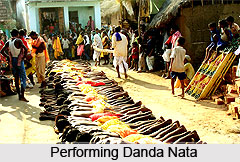 Danda Nata is a ritual dance performed by the devotees of God Hara and Parvati in the month of Chaitra and Baisakha. The dance of Danda Nata involves song, dance, music and theatre style enactments of the performers. The Danda Nata dances generally have a moral undertone which emphasises universal brotherhood and social equality. By presenting Lord Shiva and other religious Gods the Danda Nata performers try to bring in the importance of social as well as religious integrity. The Danda Nata performance may seem unsophisticated and rugged but till today it is most popular among the common masses of Orissa.
Danda Nata is a ritual dance performed by the devotees of God Hara and Parvati in the month of Chaitra and Baisakha. The dance of Danda Nata involves song, dance, music and theatre style enactments of the performers. The Danda Nata dances generally have a moral undertone which emphasises universal brotherhood and social equality. By presenting Lord Shiva and other religious Gods the Danda Nata performers try to bring in the importance of social as well as religious integrity. The Danda Nata performance may seem unsophisticated and rugged but till today it is most popular among the common masses of Orissa.
The style of presentation in Danda Nata is simple just like the common Jatra performance of Orissa. Unlike a Jatra, Danda Nata dance performance does not require a raised platform. Any open space is enough for the performance. Even the green room which the performers use to make-up and dress-up is an impoverished one.
Danda Nata is not a full story presented at a time; each sequence has its own characters for the performance. So, there is a series of sequences in which each character appears in different Veshas and Upaveshas. Some variations are noticed amongst the Veshas and Upaveshas of Danda Natas of the North, South and West Orissa. The main Vesha in Danda Nata are: the Prava, Kalika, Shiva, Chadheiya, Chadheiyani, Patra, Saura, Sauruni, Parvati, Kela, Keluni, Sabara, Sabaruni, Bai Dhana, Binakar, Karuani, etc are mostly common every where irrespective of place. The other characters, which are introduced at some places but not found in other places, are Nandi, Gunia, Narada, Baidya, Jambaba and Dwari.
There are also the Bana Durga, Vaishnavas, Gudia, Gopalunis, Lord Krishna, Gopis, Brahmin, Old Man, Narada, Dandasi, Dumbura and his mother, Jamadar, Hadi, Hadiani, Saheb, Daroga, etc. here, except the characters of Gods or Goddesses, all others are taken from the most ancient human species, nothing related to modern civilization. They are taken from the lowest layer of the society. Many times they have no materialistic belonging on their name but have their biggest asset named "the deep faith in God". One of the main characters that need to give attention is the Pate Bhokta. Not a regular character in the Danda Nata, but he is in plain clothes there through-out, not only as the chief of the `Bhoktas` but a sort of Mediator between the characters and the spectators. He may be called as the Sutradhara or the Master of ceremony in a Danda `Jatra`.
Danda Nata has a high sense of humour immersed almost in every sequence. There are battle of wits, mutual admiration, quarrels and compromise between the different couples in all sequences that cause a humour. There are many other situations in Danda Nata, where spectators laugh and enjoy the performance.
A Danda Nata mainly consists of songs in Oriya. But, in some places Sanskrit verses are also recited. Proportion of prose dialogues used is very few and at many instances, they are spontaneous. In most of the verses, the writers choose to keep the first letters of the subsequent lines in an alphabetical order from "Ka" to `Kshya". Songs for inferior characters performed are kept purposefully in local dialects. In humorous situations, mixed languages and dialects of Hindi, Telugu, and Bengali have also been seen blended interestingly. In general, in Danda Nata the language used is fluent, simple and easily understood by common man.
Finally it can be said that Danda Nata is a very intriguing a performance. It is a treat for the eyes of an onlooker to witness the Danda Nata performance of Orissa.



















